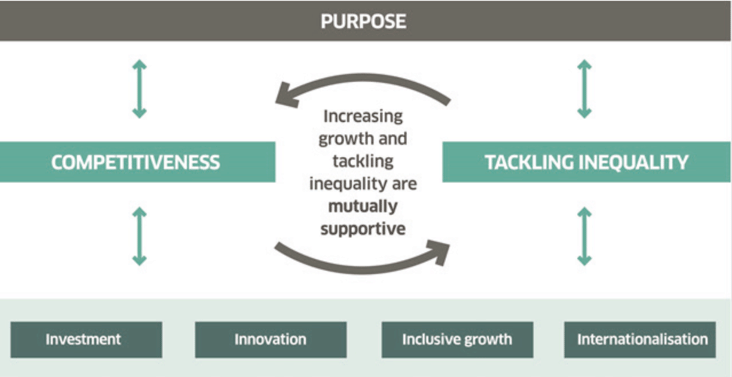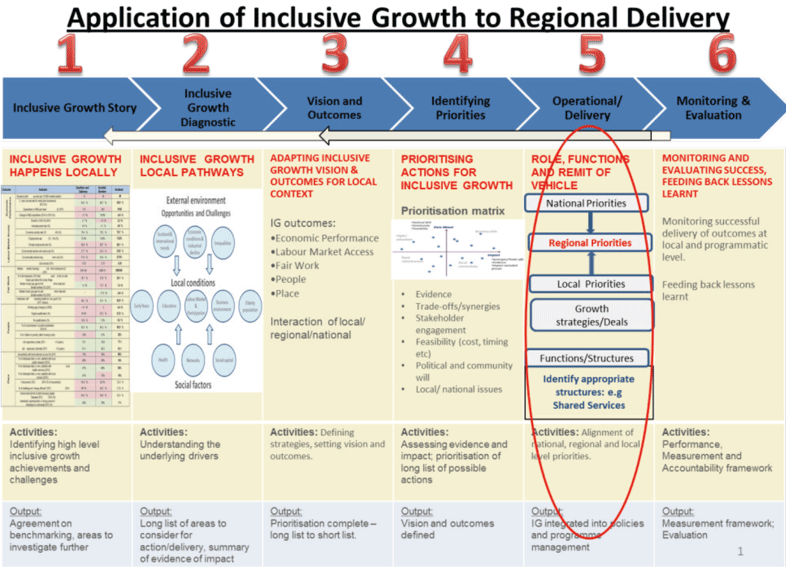Enterprise and Skills Review report on Phase 2: Regional Partnerships
Report illustrating the outcomes and progress achieved by the Regional Partnerships project as part of the Enterprise and Skills Review.
2. Purpose, vision and benefits
Inclusive growth
Scotland's Economic Strategy, published in 2015, set out our ambitions for achieving productive and inclusive sustainable economic growth. Its two mutually supportive ambitions of boosting competitiveness and tackling inequalities are underpinned by the four key strategic priorities to drive economic growth - Investment, Innovation, Internationalisation and Inclusive Growth (figure 1).
Figure 1

The introduction of Inclusive Growth as a central component of Scotland's economic strategy set out the case for ensuring an economic agenda that gives prominence to driving economic growth and productivity across all of Scotland's regions, places and communities.
Within Scotland, disparity in the rate of economic growth and output varies considerably between regions, local authorities and places. International evidence supports the view that growing inequality is harmful for long-term economic growth. Ensuring that all regions and communities can prosper is fundamentally important for Scotland's overall economic performance and to build the country and society we wish to see. This can only be achieved by successfully creating the conditions that enable all areas to have the opportunity to contribute to, and benefit from, economic success. This notion of inclusive growth has prompted the Scottish Government to consider a more holistic approach to economic development, requiring a sharper focus on actions that support and maximise regional and local economic development opportunities.
The Government's inclusive growth ambition seeks to:
- Support strong and productive inclusive economic growth across Scotland.
- Maximise the opportunities of places that have been disadvantaged by adverse impacts of economic change.
- Spread the benefits of growth more evenly within and across different parts of Scotland.
- Ensure economic and socially sustainable communities.
Making the transition to a more productive economy and inclusive society requires an understanding of issues and drivers of growth and inclusion at all levels. This must be complemented by solutions which will address the challenges of productive economic growth in different parts of the country. The Inclusive Growth regional level framework [7] has been developed as part of this project by applying and testing it across a number of economic geographies - including North Ayrshire, pan-Ayrshires (as part of the regional pathfinder work), South of Scotland and some City regions. The framework is summarised in figure 2 below.
Figure 2

The early findings of the Ayrshires analysis for the region identifies common challenges and opportunities within that economic geography. This suggests there may be scope to respond collectively across a number of areas.
The Scottish Government recognises that many of the activities set out in the regional inclusive growth delivery model are already in play in many parts of Scotland with much of the activity led by local authorities and their partners, as well as the universities, colleges and the private sector. We support this but want to encourage a more consistent use of the framework within and across regional economic partnerships going forward. For future city deals and other types of regional growth deal focussed on place, we will expect the prioritisation process to have been informed by the inclusive growth model and will give weight to activities which score well in inclusive growth terms.
We also recognise the vital importance of being able to measure success in terms of the five high-level outcomes for inclusive growth in Scotland. Those being:
- Economic Performance and Productivity - Economic growth is resilient, sustainable, and inclusive.
- Labour Market Access - Improved access to labour markets and jobs, inequality of opportunity to access work is addressed, and everyone is able to maximise their potential [8] .
- Fair Work - Fulfilling, secure and well-paid jobs, where employees' contributions are encouraged, respected and valued [9] .
- People - Economic benefits and opportunities are spread more widely across Scotland's population, with lower poverty levels, and more equal income and wealth distribution.
- Place - More economic opportunities across Scotland's cities, towns, regions and rural areas, ensure sustainable communities.
We are developing an Inclusive Growth Monitoring Framework which will incorporate clear indicators to measure progress towards these outcomes. This is being taken forward as part of the work to refresh the National Performance Framework.
Given the clear commitments in all region deals we will expect future monitoring of City and Growth deals to be informed by this work. We will also expect regional partners to produce annual monitoring reports including assessments against these outcomes, utilising the emerging framework.
Creating the conditions for success
We want a Scotland characterised by the different models of economic partnerships which local circumstances suggest will best stimulate local economies; we want to deliver improved regional economic performance which is also inclusive and to ensure enterprise and skills services can be delivered at the most appropriate level for the end user.
Across Scotland partners are working together to identify opportunities to make a difference and improve outcomes for local people. Different models of partnership responding to regional needs and priorities have emerged, and we welcome this flexibility [10] .
The establishment of regional partnerships has been supported by local partners recognising the opportunities that come in working across boundaries and supported by agencies building on their CPP contributions. That bottom-up approach is key to their success, delivering clear local leadership and empowerment. Prescription of a national model would undermine that. While we support the emergence of regional approaches developed to suit regional circumstances, this review sought a means to bring structure to the range of approaches being developed, to secure greater long-term impact, improvement and support best practice.
Analysis of existing partnerships suggests there are certain characteristics which make successful partnership delivery more likely. Moving forward we expect that partnerships seeking government support for investment will provide clear evidence of all of the following:
- Leadership - strong leadership across the public, private and third sector which fosters a culture of genuine trust and deep collaboration, develops a vision for the region, drives action and rallies support.
- Strategy - a clear and compelling economic vision co-produced and owned by the partners which clearly articulates their respective roles and contribution.
- Understanding - A deep understanding of the assets, challenges and constraints of the regional economy; A plan for the regional partnership derived from this and a measurement framework which allows progress to be tracked.
- Purpose - a commitment to add value to the activity already undertaken by the Scottish Government and partners within the region to achieve greater benefit for the regional economy by aligning partnership assets and investment.
Our experience and international comparison tell us that these attributes are better able to stimulate growth by:
- Identifying synergies and common priorities across the region for co-ordinated and focused action designed to deliver growth.
- Embracing private sector leadership, expertise and networks to amplify growth opportunities and co-design the support necessary to unlock the full potential of the area, its businesses and people.
- Strengthening connections between schools, colleges, businesses and the enterprise and skills development system.
- Decluttering the landscape for service users, improving integration and awareness of the full suite of support available, including private and third sector provision.
- Increasing the potential to maximise economic benefit from all regional assets and developing clusters of strength.
- Helping align activity such as strategic spatial planning of development and infrastructure planning.
While recognising that business leaders may face time constraints associated with running their businesses, ensuring active and engaged private sector partners help lead, shape and deliver the priorities of any existing or future Partnership is key to their success. For this reason moving forward the Scottish Government will expect private sector representation on regional partnerships, in most circumstances and certainly where government investment is sought.
Governance
Good governance is at the heart of all successful organisations and should deliver clarity and confidence for partners and stakeholders. It can help empower a partnership and ensure clear roles and responsibilities. In considering legal forms of governance partners must be clear about the purpose, deliverables and necessary capacities of the partnership. There is a range of options that a regional partnership could adopt including:
- A Partnership Agreement, underpinned by a Memorandum of Understanding.
- A Joint Committee of councils, possibly accompanied by Partnership Agreements regulating wider partners' commitment.
- A Limited Liability Partnership.
Until now most regional partnerships have taken the form of a Joint Committee under the Local Government (Scotland) Act 1973. A joint committee of this sort has the scope to assume responsibility for a range of local authority functions. It also enables members from outwith a local authority. This structure helps to deliver democratic accountability. However, what is key is that the legal structure helps and does not hinder the partnership delivering effectively. We will not be prescriptive about what the right legal structure is for a Partnership, but we expect every partnership to have carefully considered its legal structure and to demonstrate that its structure enables clear governance and clarity of roles.
Contact
There is a problem
Thanks for your feedback